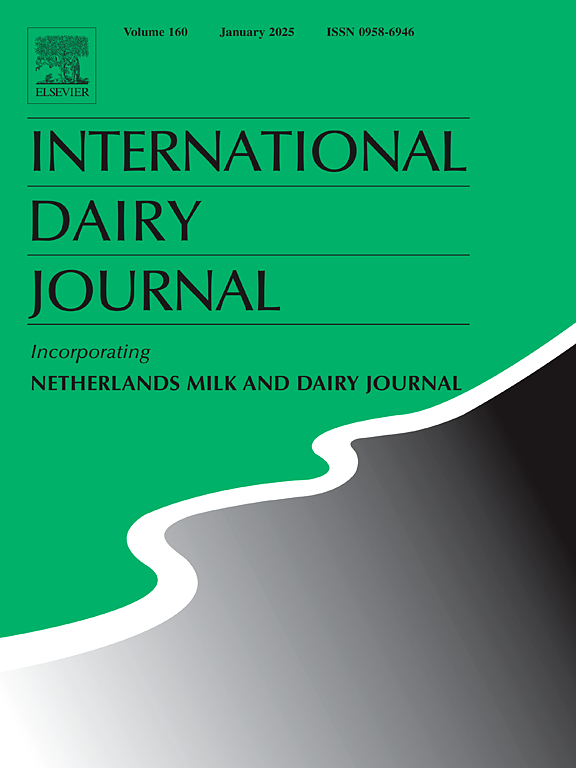从干凝乳中开发丝状意大利面奶酪:工艺创新
IF 3.1
3区 农林科学
Q2 FOOD SCIENCE & TECHNOLOGY
引用次数: 0
摘要
通过制作可储存的奶酪凝块,奶酪可以按需生产,并且减少了产品浪费。冷冻是生产可储存奶酪凝乳的一种可能;然而,冷冻储存与成本有关。干奶酪凝乳是一种可行的替代品。当奶酪生产时,必须恢复其技术功能特性。这项研究调查了是否有可能从干凝乳中生产意大利面条式奶酪。因此,采用了两种方法:1)干燥的奶酪凝乳再水化并进行机械热处理,而不进一步加水(DR); 2)干燥的奶酪凝乳用热拉伸水进行机械热处理,而不事先再水化(DHW)。使用未干燥的样品作为参考(Ref)。研究发现,60分钟的补水是必要的,以吸收水分,生产具有可接受/凝固干物质的意大利面条式奶酪。因此,补液时间在技术上和小规模上是可以接受的。不进行复水化处理,干物质含量高,奶酪产量低。此外,由于干燥过程,脂肪含量会有一些损失,在干燥过程中,脂肪融化并部分退出奶酪凝乳。共聚焦激光扫描显微镜(CLSM)图像显示脂肪球变大并聚集。DHW在20℃时的存储模量(G′20℃)最高,Ref次之,dr次之。处理时间越长,DHW在G′20℃时的存储模量越低。在所有情况下均可获得塑化,tan δmax约为1.2-1.4。本文章由计算机程序翻译,如有差异,请以英文原文为准。
Development of pasta filata style-cheese from dried curd: A process innovation
By making a storable cheese curd, cheese can be produced on demand, and product waste is reduced. Freezing is one possibility for producing storable cheese curd; however, storage in a frozen state is associated with costs. Dried cheese curd could be a viable alternative. Techno-functional properties must be regained when the cheese is produced. This study investigates whether producing pasta filata-style cheese from dried curd is possible. Therefore, two approaches were pursued: i) dried cheese curd was rehydrated and thermomechanically treated without further addition of water (DR) ii) dried cheese curd was thermomechanically treated with hot stretching water without prior rehydration (DHW). A non-dried sample was used as a reference (Ref). It was found that rehydration of 60 min is necessary to absorb the water to produce a pasta filata-style cheese with acceptable/set dry matter. Rehydration time is therefore acceptable on a technical and small scale. Without rehydration (DHW), the dry matter content is high, and cheese yield is low. In addition, there are some losses in fat content due to the drying process, where fat melts and partly exits the cheese curd. Confocal laser scanning microscopy (CLSM) images show that fat globules become larger and agglomerate. The storage modulus at 20 °C (G′20 C) is highest for DHW, followed by Ref and then DR. Longer treatment times tend to decrease G′20 °C for DHW. Plasticization is obtained in all cases with a tan δmax of approximately 1.2–1.4.
求助全文
通过发布文献求助,成功后即可免费获取论文全文。
去求助
来源期刊

International Dairy Journal
工程技术-食品科技
CiteScore
6.50
自引率
9.70%
发文量
200
审稿时长
49 days
期刊介绍:
The International Dairy Journal publishes significant advancements in dairy science and technology in the form of research articles and critical reviews that are of relevance to the broader international dairy community. Within this scope, research on the science and technology of milk and dairy products and the nutritional and health aspects of dairy foods are included; the journal pays particular attention to applied research and its interface with the dairy industry.
The journal''s coverage includes the following, where directly applicable to dairy science and technology:
• Chemistry and physico-chemical properties of milk constituents
• Microbiology, food safety, enzymology, biotechnology
• Processing and engineering
• Emulsion science, food structure, and texture
• Raw material quality and effect on relevant products
• Flavour and off-flavour development
• Technological functionality and applications of dairy ingredients
• Sensory and consumer sciences
• Nutrition and substantiation of human health implications of milk components or dairy products
International Dairy Journal does not publish papers related to milk production, animal health and other aspects of on-farm milk production unless there is a clear relationship to dairy technology, human health or final product quality.
 求助内容:
求助内容: 应助结果提醒方式:
应助结果提醒方式:


